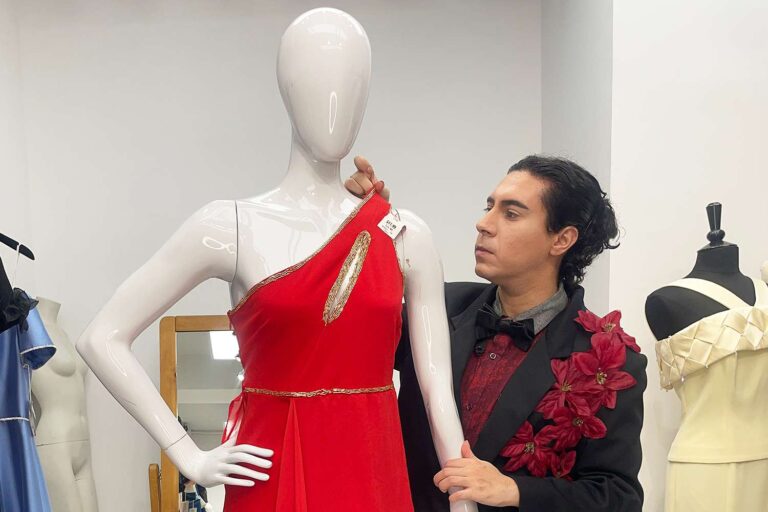- Evan Hirsch gave him a unique makeover by purchasing a $6 dress from Goodwill.
- After spending hours of hand beads and adding more to his clothes to make him a prom dress, Hirsch returned the gown to Goodwill.
- He hopes that by doing this, people can do it that they can’t regularly buy unique pieces for custom-made gowns at affordable prices.
By revamping the $6 simple dress from Goodwill, Evan Hirsch is creating more than just clothing.
This gesture is a fusion of creativity, sustainability and give-back. The inspiration for this project comes from a desire to help others.
“I originally had the idea of giving away gifts for the prom season,” Hirsch tells only people. “I wanted to give someone the opportunity to bring the dress of their dreams back to life. When a prom dress could be expensive and there was a problem with two people wearing the same gown, I wanted to reduce some of the stress.”
However, the logistics of the giveaways turned out to be challenging – he came up with the idea that would benefit others and showcase his creativity.
“That was when the idea was to choose a ready-made dress at Goodwill, give it a couture makeover, document the process and put it back on the rack.
The time Hirsch spent working through the dress has obviously increased the price of the sticker, but by bringing it back to Goodwill, he is effectively removing the barriers that cost creates. “You have to get each strand of beads and tack them,” explains Hirsch. “Each bead on the strand is secured individually to the dress. This is a time-consuming effort.”
Evan Hirsch
Hirsch’s project is a statement on many levels, particularly accessibility and sustainability.
“A lot of people can’t say they have couture dresses made for them,” Hirsch tells people. With the rise of fast fashion, the idea of owning custom pieces is becoming more and more unusual.
You won’t miss the story. Sign up for people’s free daily newsletters and stay up to date with what people have to offer, from celebrity news to stories of fascinating human interests.
By upcycling ignored clothing, Hirsch wants to give someone the opportunity to experience the beauty and craftsmanship that comes with creating a piece.
“When I found the red bebe cocktail dress at Goodwill, it peaked and there was a noticeable loose thread in the center front at the top,” he says. “We thought that giving this piece a couture makeover could improve the overall appeal of the dress.”
Evan Hirsch
Sustainability is at the heart of his project. “Fashion is one of the most wasted industries,” the designer admits. “And I’m not going to act like I’m not part of the problem. I’m a guilty of overconsumption, especially when it comes to buying fabrics and maintaining inventory. But making more projects like this will help me play a small role in fighting this waste.”
Upcycling allows him to breathe new life into items that may be abandoned or overlooked. “I love doing upcycling projects. Reusing something to give you a new life gives you a good feeling, which is especially rewarding when you know it’s useful for your environment,” says Hirsch.
However, this dress is not his first project of this kind. From converting an old corduroy jacket into a messenger bag to turning a blouse into a skirt, upcycling is a passion he intends to continue exploring. He also advocates that more designers will embrace it.
Evan Hirsch
“I think more designers should definitely consider upcycling, but I am aware of the challenge,” he admits. “Most designers want to make clothes and sell a lot of units. If the design is a custom deadstock upcycled piece, it becomes more and more difficult. But there are audiences who appreciate the one-off design and sustainability aspects.”
Hirsch was surprised by the number of people who resonated with his project and the idea of finding hidden gems that evoke sentimental value.
Ultimately, this project is more than just fashion, but it is about giving back and fostering a sense of community. “My hope is for the dress to make it for those who appreciate it,” says Hirsch.
Evan Hirsch
The designer bought the dress for just $6, but the bargain was at the selling price. When he put the dress back into goodwill, he learns that the sale will end and the dress will be reverted to the rack for the original price of $11.99.
Nevertheless, by offering one of his works at an accessible price, Hirsch can achieve a little more of the art of fashion for those who never thought of it.
On April 9th, Hirsch will be exhibiting its bridal collection on the official CFDA New York Bridal Week Calendar. The final piece is a thrift store dress where he beads again and returns.


